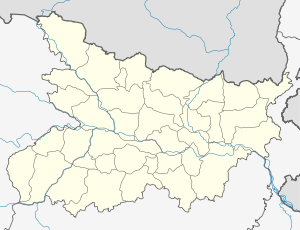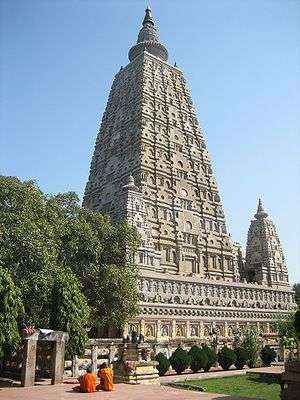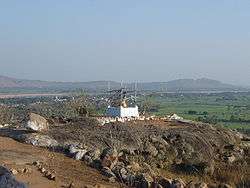Gaya, India
| Gaya गया | |
|---|---|
| City | |
|
Brahmayoni hill, where Buddha taught to Fire Sutta | |
 Gaya Location of Gaya in Bihar | |
| Coordinates: 24°45′N 85°01′E / 24.75°N 85.01°ECoordinates: 24°45′N 85°01′E / 24.75°N 85.01°E | |
| Country |
|
| State | Bihar |
| Region | Magadha |
| Division | Magadh Division |
| District | Gaya |
| Government | |
| • Type | Municipal corporation |
| • Body | Gaya Nagar Nigam |
| • Mayor | Soni Kumari |
| Area[1] | |
| • Total | 90.17 km2 (34.81 sq mi) |
| Elevation | 111 m (364 ft) |
| Population (2011) | |
| • Total | 863,454 |
| • Rank | 98th |
| • Density | 9,482/km2 (24,560/sq mi) |
| Demonym(s) | Gayaite |
| Languages | |
| • Official | Hindi, English and Urdu |
| Time zone | IST (UTC+5:30) |
| PIN | 823001 - 13 |
| Telephone code | 91-631 |
| Vehicle registration | BR 02 |
| Railway Station | Gaya Junction |
| Airport | Gaya International Airport |
| Website |
www |
Gaya (/ɡʌjɑː/) is a city of ancient historical and mythological significance. It is one of the major tourist attractions of Bihar. The city is the second largest city of Bihar, after Patna[2] and is also the headquarters of Gaya district and Magadh division.
Gaya is 100 kilometers south of Patna, the capital city of Bihar. Situated on the banks of the Phalgu River (or Niranjana, as mentioned in Ramayana), it is a place sanctified by the Jain, Hindu, Islam and Buddhist religions. It is surrounded by small rocky hills (Mangla-Gauri, Shringa-Sthan, Ram-Shila and Brahmayoni) by three sides and the river flowing on the fourth (eastern) side. The city has a mix of natural surroundings, age old buildings, green areas and narrow bylanes.
History


Ancient history
Documented history of Gaya dates back to the enlightenment of Gautam Buddha. About 11 km from Gaya town is Bodh Gaya, the place where Gautam Buddha attained enlightenment. Since then the places around Gaya (Rajgir, Nalanda, Vaishali, Pataliputra) had been the citadel of knowledge for the ancient world. These centers of knowledge further flourished under the rule of dynasties like the Mauryans who ruled from Pataliputra (modern Patna) and covered the area beyond the boundaries of the Indian subcontinent. During this period, Gaya was a part of the Magadh region.
Origin of name
Gaya derives its name from the mythological demon Gayasur (which literally means Gaya the demon). According to Vayu Purana, Gaya was the name of a demon (Asura) whose body was pious after he performed rigid penance and secured blessings from Vishnu. It was said that the body of Gayasura was transformed into the series of rocky hills that make up the landscape of Gaya.[3]
Modern history
The town of Gaya, in about 1810 AD, consisted of two parts : one the residence of the priests, which properly was called Gaya ; and the other the residence of lawyers and tradesmen, which was originally called Elahabad, but later on,as developed by a renowned collector "Saheb"- Mr.Thomas Law, it was called Sahebgunj.It is the birthplace of eminent nationalist Bihar Vibhuti Dr Anugrah Narain Sinha;Bihar's first deputy Chief Minister cum Finance Minister.The last great ruler of Magadha was maharaja of Tekari.
The leader of Kisan Andolan, Swami Sahajanand Saraswati established an ashram at Neyamatpur, Gaya (Bihar) which later became the centre of freedom struggle in Bihar. All the prominent leaders of Indian National Congress visited there frequently to meet Yadunandan (Jadunandan) Sharma, the leader of Kisan Andolan who resided in the ashram set up by Swamiji. Yadunandan Sharma became the undisputed leader of peasants in the Gaya district and second in command to the legendary freedom fighter and peasant leader Swami Sahajanand Saraswati.[4] Gaya has also immensely contributed in the Indian Independence Movement.
During the independence movement, the All India session of the Congress was held under the presidency of Deshbandhu Chittaranjan Das in 1922, which was attended by great illumanaries and prominent leaders of the Indian Independence Movement, such as Mohandas K. Gandhi, Dr. Rajendra Prasad,Dr Anugrah Narayan Sinha, Sardar Patel, Maulana Azad, Jawaharlal Nehru and Sri Krishna Sinha.
The current Chief Minister of Bihar,is nitish kumar & former Bihar Chief Minister Late Satyendra Narain also hailed from Gaya.
Shri Ishwar Chaudhary was a member of Fifth, Sixth and Ninth Lok Sabha during 1971-79 and 1989-91 representing Gaya constituency of Bihar.
Establishment of the Gaya District
Gaya was established in the year 1865. Earlier Gaya was a part of the district of erstwhile Behar of Ramgarh (now in Jharkhand state) till 1864. It was given the status of independent district on 3 October 1865. Subsequently, in May 1981, Magadh division was created by the Bihar state government with the districts of Gaya, Nawada, Aurangabad and Jehanabad. All these district were at the level of sub-division, when the Gaya district was created. Gaya has seen three district partitioned off from its territory, Aurangabad and Nawada in 1976; and Jehanabad in 1988. Gaya district occupies an area of 4,976 km2 (1,921 mile2) comparatively equivalent to the island of Trinidad.
Climate
As Gaya is surrounded by hills from three sides and one side by rivers so the climate of Gaya is seasonable (means in winter it is too cold and in summer it is too hot). Climate is characterized by relatively high temperatures and evenly distributed precipitation throughout the year. The Köppen Climate Classification sub-type for this climate is "Cfa" (Humid Subtropical Climate).[5]
| Climate data for Gaya, India | |||||||||||||
|---|---|---|---|---|---|---|---|---|---|---|---|---|---|
| Month | Jan | Feb | Mar | Apr | May | Jun | Jul | Aug | Sep | Oct | Nov | Dec | Year |
| Average high °C (°F) | 24 (75) |
27 (80) |
33 (92) |
39 (102) |
41 (105) |
38 (101) |
33 (92) |
32 (90) |
33 (91) |
32 (89) |
29 (84) |
25 (77) |
32.2 (89.8) |
| Average low °C (°F) | 10 (50) |
13 (55) |
18 (64) |
23 (74) |
27 (80) |
28 (82) |
26 (79) |
26 (78) |
25 (77) |
22 (71) |
14 (58) |
10 (50) |
20.2 (68.2) |
| Average precipitation mm (inches) | 20 (0.8) |
20 (0.8) |
13 (0.5) |
8 (0.3) |
20 (0.8) |
137 (5.4) |
315 (12.4) |
328 (12.9) |
206 (8.1) |
53 (2.1) |
10 (0.4) |
3 (0.1) |
1,133 (44.6) |
| Source: Weatherbase[6] | |||||||||||||
Economy
Gaya is the second biggest economy contributor after Patna for Bihar. It has a large number of household industries like production of agarbattis, production of tilkut and lai, stone crafting, power looms, Small Scale manufacturing industries,packing industries,plastic products industries,Scrap Industries and hand looms. Gaya functions as a service centre for the surrounding towns and villages. Commercial activities are located along the important roads of the town. The main vegetable market in the city is the Kedarnath Market. In additional the city has a large number of informal shops. On account of Gaya being an important centre for religious tourism, the city has a large number of costly and affordable Hotels and accommodations. Gaya has the highest number of hotels in Bihar & Jharkhand. One Five Star hotel is also proposed in Bodh gaya.
There are no Large Scale Industries / Public Sector undertakings in the city. The industries in the city are mainly affected by shortage of electricity power problem. Credit facility with banks. Lack of knowledge on export marketing. Lack of market network. Latest technology available to improve quality as well as product etc.[7]
Recently, Gaya has been chosen as one of the heritage cities for HRIDAY - Heritage City Development and Augmentation Yojana scheme of Government of India.Gaya city is also proposed in the list of 100 Smart City to be developed by NDA govt. The city also boasts of a shopping mall named APR City Centre and also an upcoming megamall, the Amrapali Mall.
Demographics
As per 2011 census, Gaya Urban Agglomeration had a population of 863,454.[8] Gaya Urban Agglomeration includes Gaya (Municipal Corporation), Kaler (Out Growth) and Paharpur (Census Town).[9] Gaya Municipal Corporation had a total population of 863,454, out of which 445,764 were males and 417,690 were females. The population below 5 years was 29,015. The sex ratio was 986. The literacy rate for the 7+ population was 85.74 per cent.[10]
Transportation
Gaya is well connected to the rest of India by roads, airways and railways. The Grand Chord section of the Indian Railways passes through Gaya. It also has an airport which has services for some South-Asian destinations and also to many places in our country.
Local transport
Many City buses, taxis, tongas, auto rickshaw, cycle rickshaws ply across the city and for Bodhgaya. The local transport facility is very good. Nearly, many auto rickshaws are available to various destinations in the city.
Roadways
Regular direct bus services run from Gaya to Patna, Bhagalpur, Munger, Nalanda, Rajgir, Varanasi, Ranchi, Jamshedpur, koderma, Durgapur, Asansol, Kolkata and Dhanbad. In 2011, A/C Mercedez Benz Luxury services have been introduced by Bihar State Road Transport Corporation for Muzaffarpur, Patna, Munger, Bhagalpur, Motihari, Hazaribagh, Koderma, and Ramgarh.
The National Highway 2 Grand Trunk Road from Kolkata to Delhi passes about 30 km from Gaya. This connects Gaya to Patna, Ranchi, Jamshedpur, Bokaro, Rourkela, Durgapur, Kolkata (495 km), Varanasi (252 km), Allahabad, Kanpur, Delhi, Amritsar, and to the Pakistani cities of Lahore and Peshawar. Gaya is connected to Patna (105 km) by NH 83, Nawada, Rajgir (78 km) and Bihar Sharif by NH 82. Plans have been made to construct a four lane road from Gaya to Patna
Railways
Gaya Junction railway station is a junction station serving the city. Gaya junction was also proposed in the list of 66 Station to be built of International standard by Mamta Banerji in UPA II gov.Gaya junction was the only station in Bihar and Jharkhand qualify in the list of 66. Gaya falls under the jurisdiction of Mughalsarai railway division of the East Central Railway zone. Grand Chord rail-line that connects Howrah and New Delhi passes through Gaya. It lies between Mughalsarai Junction on the Delhi side and Dhanbad Junction on the Howrah side. It is located at 24°48′13″N 84°59′57″E / 24.80361°N 84.99917°E.[11] It has an elevation of 117 metres (384 ft). Gaya is connected with most of the states through rail network. Very few trains do-not stop here . There are also two other broad gauge train lines from Gaya, one to Patna and the other to Kiul Junction. The city has major two railway station Gaya Junction & Manpur Junction. Gaya is well connected with Patna, Jehanabad, Biharsharif, Rajgir, Islampur, Nawada through daily passenger and express train services.
There are direct trains from Gaya to important stations in India like Delhi, Kolkata, durgapur, Asansol, Chennai,Kamakhya - [Guwahati], Ranchi, Parasnath(Shikharji), Bokaro, Varanasi, Lucknow, Kota, Kanpur, Allahabad, Agra, Bareilly, Mathura, Jabalpur, Bhopal, Indore, Nagpur, Mumbai, Pune, Puri, Ahmedabad, Jodhpur, Amritsar, Dehradun, Kalka, Jammu, Gwalior, Dehradun, Jamshedpur(Tatanagar), Bhuvaneshwar, etc. Gaya has the highest number of Rajdhani train stoppage in Bihar and Jharkhand.It the most important railway route for West Bengal. Several frequent electrified local passenger trains also run from Gaya to Patna and other neighbouring destinations at regular intervals.[12][13]
Airport
Situated between Gaya (7 km) and Bodh Gaya (11 km), Gaya Airport is the largest (by area) and only operating international airport in Bihar and Jharkhand. It is connected to Jeddah,Saudi Arabia for carrying Hajis every year for annual pilgrimage to holy city Makkah,Saudi Arabia;Colombo, Sri Lanka through two airline operators; Bangkok, Thailand; Singapore and Paro, Bhutan. It is said to be being developed as a stand-by to the Kolkata airport.[14] Gaya Airport is served by Air India for domestic flights and Sri Lankan Airlines, Mihin Lanka, Drukair, Jet Airways, Thai Airways and Indian Airlines for international flights. Currently, there are domestic operations to New Delhi, Kolkata, Varanasi from this airport. Gaya International Airport has been also granted to facilitate e-Visa on arrival to 87 countries including European Countries, USA, Japan,Thailand and others.Visa on Arrival is the only facility available in Gaya in Eastern Part of India.
References
- ↑ "City Development Plan for Gaya: EXECUTIVE SUMMARY" (PDF). Urban Development and Housing Department, Government of Bihar. p. 4. Retrieved 8 October 2012.
- ↑ http://www.censusindia.gov.in/2011-prov-results/paper2/data_files/India2/Table_3_PR_UA_Citiees_1Lakh_and_Above.pdf
- ↑ "The Hare Krsnas - Battles of Vishnu Avatars - Gayasur". Harekrsna.com. Retrieved 2016-01-07.
- ↑ Das, Arvind Narayan (1982). Agrarian Movements in India: Studies on 20th century Bihar. Routledge.
- ↑ "Climate Summary for Gaya, India". Weatherbase.com. Retrieved 2016-01-07.
- ↑ "Weatherbase.com". Weatherbase. 2013. Retrieved on July 31, 2013.
- ↑ http://dcmsme.gov.in/dips/Gaya_BIHAR.pdf
- ↑ "Urban Agglomerations/Cities having population 1 lakh and above" (PDF). Provisional Population Totals, Census of India 2011. Retrieved 2012-04-16.
- ↑ "Constituents of urban Agglomerations Having Population 1 Lakh & above" (PDF). Provisional Population Totals, Census of India 2011. Retrieved 2012-04-16.
- ↑ "Cities having population 1 lakh and above" (PDF). Provisional Population Totals, Census of India 2011. Retrieved 2012-04-16.
- ↑ "Gaya Junction". Wikimapia. Retrieved 2011-12-01.
- ↑ "Trains at Gaya". India Rail Info. Retrieved 1 April 2012.
- ↑ "Ghanbad Junction Railway Station Details". indiantrains.org. Retrieved 1 April 2012.
- ↑ "Airport land issue: Patna's loss, Gaya's gain". The Times Of India.
External links
| Wikimedia Commons has media related to Gaya, India. |
- Entry on Gaya in the Buddhist Dictionary of Pali Proper Names
- Suttas spoken by Gautama Buddha concerning Gaya: (more)
-
 Gaya travel guide from Wikivoyage
Gaya travel guide from Wikivoyage
| ||||||||||||||||||||||||||||||
| ||||||||||||||||||||||||||||||||||||||
